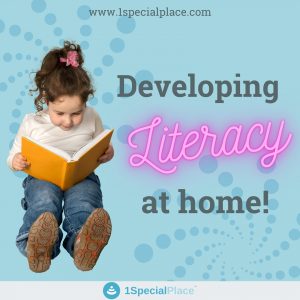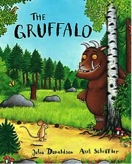Developing Literacy at Home
Developing Literacy at Home
 One of the most important things you can do to prepare your child for school success is to develop early literacy skills. Building literacy at home is all about having fun. All it requires is you, Children learn best not by being “taught”, but by having enjoyable interactions with their family.
One of the most important things you can do to prepare your child for school success is to develop early literacy skills. Building literacy at home is all about having fun. All it requires is you, Children learn best not by being “taught”, but by having enjoyable interactions with their family.
Development of Reading Readiness in your child
Here are some fun tips for building five critical early literacy skills your child needs to develop before they start school
1. Oral Language
During book reading, it is important to pause, make a comment and ask a question so that child would have the opportunity to think and talk about the story. This would improve their comprehension and oral language skills – key foundations for literacy success.
Example: when you read “Three little pigs” story, pause and observe them closely to see how they react to what the wolf does and then ask questions such as “what will happen to the wolf when he gets down the chimney?”. Remember to be enthusiastic and wait expectantly for your child to respond. Developing Literacy at Home
2. Vocabulary
Build your child’s vocabulary by stressing on new words, talking about its meaning and relating it to child’s experience. The more words they learn, the better their reading comprehension will be later on.
Example: when the wolf from “The Three Little Pigs”, puffed out the house made out of straw. This book provides a great opportunity to help your child learn a new word: “puffed out”. Explain what the word means by using simpler words your child already knows (for example, “puffed out” means blowing) and relating the word to your child’s experience. Developing Literacy at Home
3. Story Comprehension
The easy way for a child to understand the story is by talking about the characters, settings, problem, actions, and solution.
Taking the previous example,” the wolf had puffed out the straw house (which is the problem in this story). How would you handle such crisis?”
In addition to the above, it is important to develop the child’s critical thinking skill to fully understand the story.
Experiences — connect the story with your child’s knowledge and experiences
For example, when you read “Goldilocks and the Three Bears” story, start a little conversation during reading, by saying something like; “remember the day when we shopped for your mattresses”.
Explain — help the child to understand why the events happen in the story.
Taking the book from the previous example, ask questions such as; “Why Goldilocks spat the porridge?”. Acting out the story would improve this skill.
Problem-solve — help the child to think of possible solutions to solve the problem.
Use a thinking-out-loud comment – Thinking-out-loud comments start with words like, “I’m thinking that…” or “I’m wondering about…” These kinds of comments show your child how you are thinking about the book and encourage her to think along the same lines.
For example, while reading “The Three Little Pigs”, make a comment like “I am wondering what the pig could do to frighten away the wolf”, pause, and wait for the child to come up with solutions.
Predict — while reading the story, make the child to guess what happens next in the story.
Taking the story from the previous example, ask questions like; “Do you think the first two little pigs will build new houses now?”
As you and your child talk about the story, keep “E’s and P’s” at the back of your mind. These are the things your child needs to think about to exercise their critical thinking skills and deepen her understanding of the story. Developing Literacy at Home
Tips to improve reading in toddlers.
4. Print Knowledge
It is important for the child to learn about the print before they learn to read/write on their own. That is print represents spoken language and it is read from left to right. So when you read with the child, point out and talk about some these print ideas to help your child learn.
Example: I’m a Frog! by Mo Willems, this book has speech balloons which gives you the opportunity to talk how the text in the balloon shows what the characters are saying. “Look, we read this to find out what Piggy is saying.”
5. Sound Awareness
Sound awareness prepares the child for reading by making it easy for them to sound out the words which she will read later on. To develop this skill, the child must understand that the words can be broken down to smaller sounds and that letters correspond to certain words.
The Gruffalo by Julia Donaldson offers great opportunity to build your child sound awareness because it has full of back to back words beginning with the same sounds. While reading the book, point out two words that start with the same sound and ask your child to think of another word that starts with that sound. For example, “Look, ‘scrambled’ and ‘snake’ both start with the ‘Sss’ sound. Listen. ‘Ssscrambled Sssnake’. Can you think of another word that starts with the ‘Sss’ sound?” Remember to talk about the sound the letter makes rather than the name of the letter.
BUILDING LITERACY IN EVERY DAY ACTIVITIES
Here are some ideas for building your child’s early literacy skills during everyday life:
- Breakfast – Point out the words (and explain what they mean, if necessary) and letters on the front of the cereal box, carton of milk, or apple juice bottle.
- Bath-time – On a shampoo or bubble bath bottle, find a word that begins with the same letter as your child’s name. For example: “That word says ‘bubble.’ ‘Bubble’ begins with the letter B, just like your name, Bala.” Some taps have the “H” for hot and “C” for cold on them, which provides another opportunity for you to point out print in your child’s environment.
- Grocery shopping – Make a shopping list together with your child, reading and pointing to the words after you write them. Take the list to the store. Look at the store flyer together when you arrive at the store and read from your list. You can also point out print on price tags and package labels as you shop. You can play a game involving sounds while you shop. For example, while you pass by the milk section, tell your child “I’m looking for something in this aisle that starts with the ‘mmmm’ sound. Can you help me find something that starts with ‘mmm’?” You may have to add a clue such as, “It’s something we drink that is white.”
- In the car – Develop your child’s sound awareness by playing a guessing game. Take turns thinking of words that rhyme or start with the same sound. For example, “I’m thinking of an animal that starts with the “tuh” sound”. Again, you may have to add clues if your child is unable to answer, such as, “It’s a big cat with stripes.” Developing Literacy at Home
- On a walk– Stimulate your child’s sound awareness by finding things that start with the same sound (“Simon says to find something that starts with the sound ‘ssss’”. Taking the child out for a walk is also a great time for conversation and for highlighting new words, like “bungalow”, “cab”, “signal”, “lamppost”, “dew”, or “pedestrian.”
- Bedtime – Follow your child’s lead in choosing the story and observe their interest while reading the book with your child. Ensure that you are having a back-and-forth conversation about the book, pause, and wait for your child to participate.

Choosing the best books for reading with your child:
Toddler |
Pre-schooler |
|
Type of book
|
|
|
How to share books |
|
|
Adding language |
|
|
For more information regarding the choice of book, check out Sharing Books with Toddlers, The Hanen Way” and “Sharing Books with Preschoolers, The Hanen Way”.
Source: http://www.hanen.org/Helpful-Info/Early-Literacy-Corner/Literacy-at-Home.aspx
Information on Dyslexia and learning disability.
Developing Literacy at Home
View this post on Instagram
- Best Books for Children with Autism Spectrum Disorder - December 20, 2022
- Selective Mutism - November 13, 2021
- Everyday Items as Awesome Toys: Play Dough - July 27, 2021





Leave a Comment
(0 Comments)